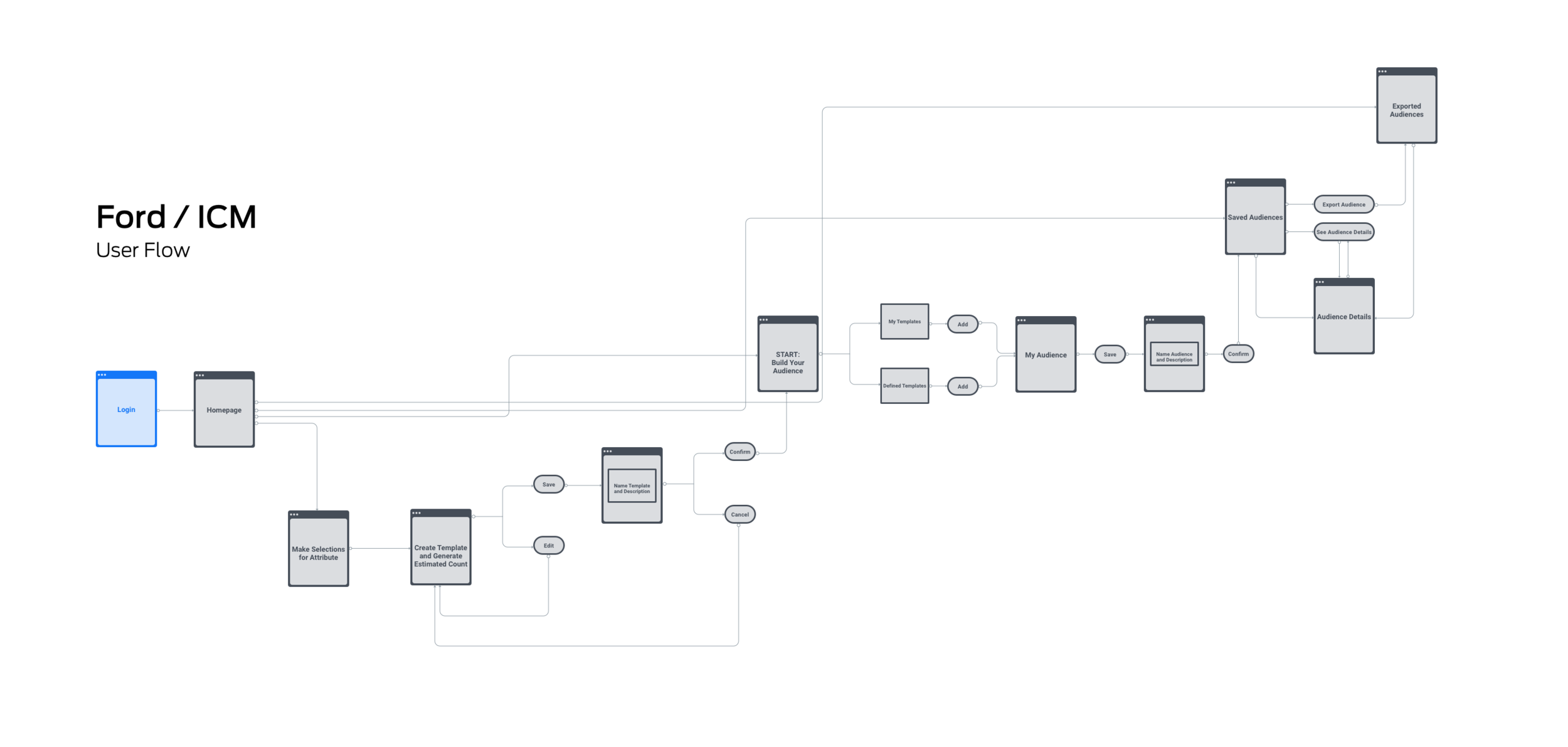Dearborn, MI
Ford Motor Company / ICM
Responsibilities: Product Design, Research, User Testing, Design Systems, Prototypes, User Flows, Wireframes
Scroll ↓
Pulling from multiple data sources for Intelligent Customer Interactions
Project Overview: ICM (Intelligent Campaign Manager) is a user-friendly application that Ford Marketing Specialists can use to view and take action on the most up-to-date data and insights available.
Problem
Ford Data Scientists do not have a singular point of access for marketing strategists to view marketing data on current and potential Ford customers. When Marketing Strategists would begin developing an audience to target, they would have to email a team that would work with Data Scientists to determine if the targeted information on customers was available or not.
The Marketing Strategists would receive a list of customers from the Data Scientists, which would then involve back and forth correspondence with Data Scientists to determine criteria available within budget. I was tasked with solving an experience where marketing strategists could independently get the data without having to involve the Data Scientists.
Solution
I was tasked with designing an experience where Marketing Strategists could independently get the data without having to involve the Data Scientists. Our department’s success lies in its ability to continuously collect and analyze data, form insights, and deliver those insights directly to marketing professionals in a way that increases Ford’s marketing velocity and maximizes data-driven decision making. Intelligent Campaign Manager is an application designed to provide Ford’s marketing teams and agencies with improved access and clearer views into customer and vehicle data, and facilitate faster decision making related to all campaigning activities.
My work involves designing a intuitive user interface that:
Facilitates sophisticated audience building, instant audience counts
Custom, pre-defined audiences that transform outdated approaches
Immediate access to newly developed HSMS models, scores, and propensities created by the Data Scientists.
A portal to newly-available marketing data
This overview (above) provides how we pull from our data environments into ICM, as well as how ICM outputs a file to ICI/Adobe to launch campaigns.
Approach
1. User Interviews & Contextual Inquiry – I began with interviewing Marketing Strategists to determine their wants and needs. I spent several days with Ford’s Data Scientists conducting a contextual inquiry to understand the process from their perspective. The solution I developed should not negatively impact their process as they will be another user of the product.
2. Affinity Mapping – I placed each interview insight onto individual sticky notes. I grouped common insights and gave each insight a title.
3. Personas – Based on the insights from the interviews and contextual inquiry I created personas. I created these personas for the team to have a common understanding of who our users were.
4. Paper Prototype – I started with sketching out the user flow and creating a paper prototype. The purpose of the paper prototype was to rapidly test, get feedback, and iterate on the user flow and information architecture. Based on the feedback, I iterated on the design and created wireframes.
User Flow
A refined user flow was created off initial brainstorming sketches to show to development teams, project managers, and stakeholders. We worked collaboratively to structure the User Flow so that each process was as fool proof as possible while also establishing solid site architecture.
Design System
There was not an established design system for the internal product so I created a system within Sketch. The purpose of creating the design system is to give the development team a structured place to see repeatable patterns I have designed. The ICM Design System is meant to create consistency, quality and efficiency as development teams build web-based experiences.
Combining modern design with technology, this design system is a unified language and a guide for designing and developing within the Ford digital ecosystem.
Every new iteration of the product will be uploaded to InVision, with Craft providing the CSS/Coding to replicate the intended user-interface concepts.
High Resolution Prototypes & Screen Flow
High Resolution Prototypes and Screen Flow were created in Sketch. The development team iteratively built the product based on the prototypes in InVision and Craft. I paired with engineers to ensure the UI was following the design system. Being involved in daily standups with the team, I can quickly provide feedback, lead, and implement design solutions instantly.
After we had a functioning product, we conducted usability testing the first version. I held sessions in the Ford Usability Lab with Marketing Strategists that would be the end user of the product. I invited the entire development team to watch the sessions from the observation room. I also conducted a card sort/similarity matrix of the information architecture of the data available to the user. The similarity matrix through OptimalSort provides an easily readable representation of the frequency of pairings of topics being grouped together. After the research, I gathered the feedback and developed a report with recommendations.
Results
Marketing Strategists were impressed by the real-time data they could receive from the tool. It decreased back-and-forth time with the Data Scientists allowing them to focus on inputting data instead of replying to emails. This direct data access will allow quicker and better informed decision-making by the Ford marketing specialists and strategists when they need to build audiences and initiate 1:1 marketing campaigns.
The financial return (2020 Q1-Q4) derived from ICM increased data accessibility, increased campaign speed, and more precise audience targeting through deeper customer insights. The easy-to-use interface empowered a broader number of Marketing Strategists and simplified the knowledge-transfer process when new staff moved in and out of new roles.





